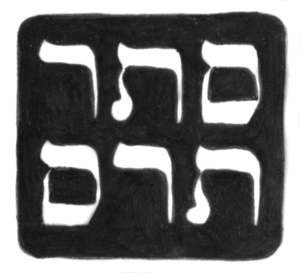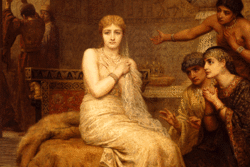Esther and Teresa: A Play on Words for Purim
I’m willing to bet there are thousands of Jewish women who grew up on Long Island in the 1950s and remember wearing extravagant costumes on Purim and parading in front of “judges” to compete for the title of Queen Esther. Mine is a fond memory: I wore my Bubbe Frieda’s green beaded flapper dress. It was definitely too long on me, but it glittered in the light and made a lovely clicking sound when I walked.
My connection to Purim begins with my Hebrew name: Esther. I was named after my other grandmother, my mother’s mother, Esther Rivka, who died suddenly when my mother was ten. On Purim when I was ten, I felt like a queen. I was Queen Esther and felt connected to all of my Jewish mothers, may they rest in peace.
My fond memories of celebrating Purim couldn’t be farther from what Teresa de Lucena (1467-1545) and her five sisters experienced in the early days of the Spanish Inquisition. For them, celebrating Purim was a death-defying act. Like Queen Esther, they lived at a time when the truth about their hidden identity could get them killed.
Teresa de Lucena made her first appearance in my life as a footnote in a book I was reading as part of my research about the Jews in Christian Spain. According to the author, Yitzhak Baer, the Inquisitors treated seventeen-year-old Teresa de Lucena leniently because she came from a prominent converso family whose ancestors had converted from Judaism to Catholicism before she was born.
At that moment, my love of Spain, my fluency in Spanish (despite the fact that I was born a descendant of Russian Jews in mid-century America) and my fascination with the Spanish Inquisition came together in a flash: I knew I was meant to tell the story of Teresa de Lucena, a conversa, who faced the Spanish Inquisition twice.
In 1988, I obtained a photocopy of Teresa’s trial dossier from the national archives in Madrid. Over the years, I taught myself to read the scribes’ elegant yet nearly illegible handwriting and translated Teresa’s testimony. I traveled to Spain to look for Teresa in the places she had lived as a young girl and visited New Mexico to learn more about the descendants of conversos and why they still revere Queen Esther today.
Let's begin with a short history:
Teresa de Lucena was born in Toledo, Spain in 1467, a violent year in a tumultuous century. She was considered a New Christian, a conversa, because her family had converted to Catholicism from Judaism before she was born, after waves of violent antisemitic riots swept across Iberia.
She was the fifth of six daughters born to a well-respected converso family of scholars and physicians. But like all conversos in fifteenth-century Spain, Teresa’s life was disrupted by civil unrest as tensions between New Christians and Old Christians erupted into violence. Teresa lost both of her parents by the time she was twelve; by seventeen, she had lived in seven homes in five cities.
In 1485, when she was seventeen, Teresa faced the Inquisition for the first time. She and her eighteen-year-old sister, Leonor, traveled together to the court in Toledo where they made the same voluntary confession: that when they were little, an aunt in Sevilla had taught them how to pray in Hebrew and how to observe the Sabbath. After promising never to return to Jewish practices, they were both “reconciled” with the Church without punishment or penalty. Not long after that, Leonor fled to Portugal and was later condemned for heresy in absentia. Forty-five years later, Teresa told the Inquisitors that although she had the chance to leave with Leonor, she “refused to go.” She never explained why.
For many years, the sisters kept in touch by letter, relying on a “trusted messenger” to keep their correspondence secret. But in 1510, the Inquisition intercepted one of Leonor’s letters, made a copy for the dossier they were keeping on Teresa, and then delivered the original to her.
In 1530, when Teresa was 62, she was arrested and held in an Inquisition jail for eighteen months. After a lengthy trial, she was found guilty of heresy on several charges, including observing Jewish practices, withholding information about others, and communicating with a known heretic. The existence of Leonor’s letter was a key piece of evidence against her. Saved by her wits and what appears to be a bargain she made with the Inquisitors, Teresa survived.
During her trial, the Inquisitors interrogated Teresa at great length about how she and others observed Jewish holy days in secret. Here is what they asked her about Queen Esther, the heroine of Purim:
Inquisitor: Did you and your sisters and parents keep the Fast of Queen Esther?
Teresa: I fasted and I think my sisters did, too.
How did you keep the fast?
I skipped meals for two or three days until it was nighttime. My sister Leonor fasted, too, and then we ate together in the evening.
In whose memory did you do this?
I did it in memory of Queen Esther, who saved the people of Israel from the hands of Haman and what King Ahasuerus was planning to do. I also fasted to make my wishes come true. I don't remember if my parents fasted.
It’s easy to understand why Teresa revered Queen Esther. Here was a hero she could relate to: a woman who hid her true identity, who found the courage to step forward and the wits to save her people.
Esther’s enduring appeal to conversos across time and space should come as no surprise. Many conversos, fleeing the long reach of the Inquisition, settled in far-flung outposts of the Spanish empire, where they created an Esther they could adore in plain sight: Santa Reina Ester or Santa Estérica. Although Esther has never been officially canonized by the Catholic Church, a rich tradition sprang up in the American Southwest, where Esther is still celebrated on July 1, her “saint’s day.”
In I, Teresa de Lucena: Reflections on the Trial of a Conversa, artist Annie Zeybekoglu and I present a wealth of information and original images about Teresa’s life, relationships, and religious practices based on our close study of her trial. But since we can’t deal with the whole Megillah in this format, for Purim’s sake, let’s close with a brief play on words.
The three consonants that form the structure of the name Esther are S*T*R (samech*tav*resh), the same three letters used in this order in Hebrew to convey the meaning: secret, hide, and conceal. Here’s the formula:
Since I know Teresa could read Hebrew and revered Queen Esther, I feel certain she was clever enough to figure out that the letters of her name—Teresa—are a permutation of the letters for Esther.
And what if she had to keep the secret from the time she was small that Esther was actually her Hebrew name? She would have had the perfect costume for Purim: Teresa was Esther, hiding in plain sight.








I love this! My name is Theresa. I recently found out that I have spanish Jewish blood. Only about 2%. I also have dna from New Iberia and Portugal. How exciting to find this article! I am named after a French and English grandmother from New Orleans where I grew up.
Thank you so much for this information.